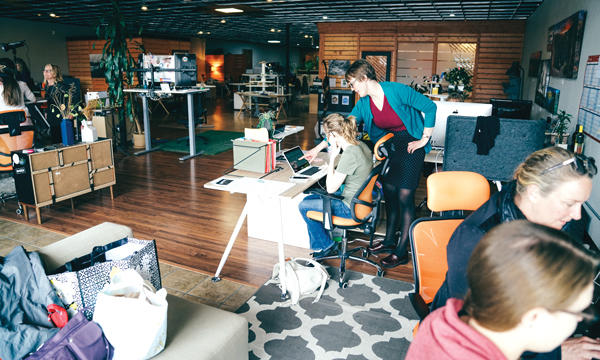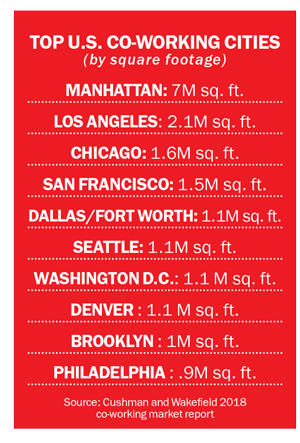Trending
The co-working cure?
The shared office trend is drawing a captive audience to neighboring shops, but oversupply of that type of work space could negatively impact retail owners

Before Josh Freed opened a 6,000-square-foot co-working facility in a pair of storefronts in Montrose, Colorado, the two spaces had stood abandoned for more than seven years.
The venture, born of a public-private partnership between Freed’s company and the city of Montrose in 2015, was meant to bring foot traffic back to the downtown area, said Freed, the co-founder and CEO of Proximity Space.
Now the space has around 70 member groups at a time and sees up to 140 people pass through it each day, the majority of whom frequent the neighboring restaurants, breweries, coffee shops and retailers, according to Freed.
Proximity Space tracks the amount of money its members spend at neighboring businesses by collecting their receipts as part of a monthly raffle. Freed said the tally stands at around $8,000 per month, which doesn’t include cash spent by clients who don’t turn in their receipts.
“[Proximity Space opened] in a side of downtown that was definitely depressed and just slow to grow,” he said. “Fast-forward two and a half years, there’s no space available to be leased down there.”
A few states away, the nine-floor Westfield San Francisco Centre was facing its own set of challenges. One wing of the mall “traditionally had a pretty high turnover rate,” and with one exception, a bevy of restaurants had tried and failed to stay open, said Cushman & Wakefield’s national retail research director, Garrick Brown.
So the shopping center took a gamble by opening a co-working, demo and event space called Bespoke on its fourth floor. Within a year, the space had drawn 100,000 additional customers to the mall, Forbes reported at the time.
It’s a tactic that is becoming more and more common in what Brown describes as the “retail apocalypse story.” The introduction of co-working space to an area means the arrival each day of dozens — if not hundreds — of potential customers for surrounding retailers.
 “Instead of trying to beat a dead horse, per se, instead of trying to [attract] retail that’s harder and harder to find, the solution is to add people,” Brown explained.
“Instead of trying to beat a dead horse, per se, instead of trying to [attract] retail that’s harder and harder to find, the solution is to add people,” Brown explained.
Co-working inventory in the U.S. has quadrupled over the past five and a half years, and half of the current inventory didn’t exist before 2015, according to a recent Cushman & Wakefield report. As of the fourth quarter of 2017, the U.S. boasted more than 34 million square feet of co-working space, making up 2.1 percent of the country’s total office inventory, the report said.
Co-working’s biggest player is making moves that acknowledge the office trend’s impact on retail. WeWork grabbed headlines last October when it purchased Lord & Taylor’s flagship store in Manhattan for $850 million in a joint venture with private equity firm Rhône Capital. The company announced plans to launch its global headquarters there in addition to leasing shared office space at the location. The department store will remain on the bottom floors.
“As a business with an emphasis on human connections in physical spaces, we will continue to create jobs within this city while simultaneously re-energizing the traditional retail experience,” WeWork founder Adam Neumann said in the announcement of the buy.
It was a reprieve for the building’s former owner, Lord & Taylor parent company Hudson’s Bay Company, which over the last few years has undergone mass layoffs.
The relationship between retail and co-working is definitely symbiotic. For co-working companies choosing a location for their facilities, proximity to retail and restaurants is an important factor, experts said. “People like the convenience of being able to go to lunch, or go shopping on their lunch breaks or after work,” said Kim Marchbank, the marketing director at TechSpace, which has nine co-working locations across the country.
Frank Bistrian, the CEO of a nascent wellness-centric co-working chain called Work Well Win — and former head of domestic development at WeWork — said opening spaces adjacent to retail supports the company’s goal of improving the quality of life of its members. “If we can reduce people’s stress by them not having to drive around the city or drive around going from place to place … then we’re doing our job,” he said.
The surrounding restaurants and retailers, meanwhile, gain a “captive audience” who will more likely than not become customers, Ronen Olshansky, the CEO of Los Angeles-based co-working company Cross Campus, pointed out.
“We have real, concrete evidence that it benefits the tenants around [co-working companies], because we’ve spoken to them,” he said. “Members know there’s so much nearby, and it definitely adds to … the hyperlocal economy.”
Todd Siegel, a senior vice president in CBRE’s Chicago office, said his firm hadn’t yet seen co-working have a quantifiable impact on retail clients, but noted that “it would make sense that retailers would want to be close to a transient population.”
“Co-working assets by their very nature are designed and built to attract and accommodate a changing population,” he said in a statement. “If I am a retailer, it feels like this would be great to build off of.”
A co-working space on the ground floor of a retail building, meanwhile, can add “a certain cool factor” to the space, according to Cushman & Wakefield’s David Smith. “There’s a certain look and aesthetic to it that draws people to the location,” he explained.
WeWork itself will soon be getting into the retail game, according to sources who told TRD that the initiative could look much like the company’s co-working model. The firm may also introduce WeWork-managed retail spaces in its buildings, sources said.
But that’s not to say that co-working itself won’t someday struggle like retail has. With so many boutique co-working firms popping up, the danger for landlords signing these tenants lies in the possibility of oversaturation, some said.
“I think the risk for owners is that they’re going to chase the co-working trend, and then the co-working trend is going to top out,” said Smith, though he noted that “well-funded leaders” like WeWork and Regus will likely be fine. “I think there will be some retail owners who chase this trend too aggressively … and then get left holding the bag when there’s a correction in the market.”
But while Smith predicts a slowdown in the market within the next two to four years, he still sees “a fair amount of demand” for co-working at present.
“The good news for retail landlords is we’re not there yet,” Brown added.




